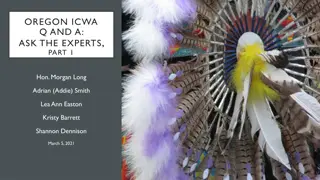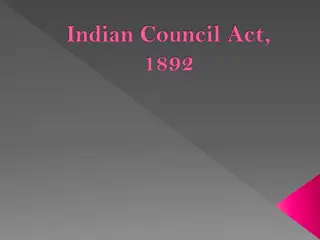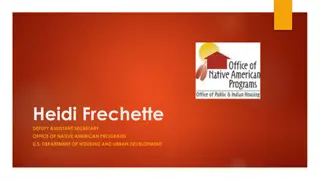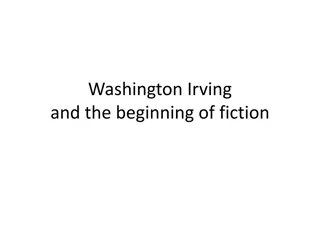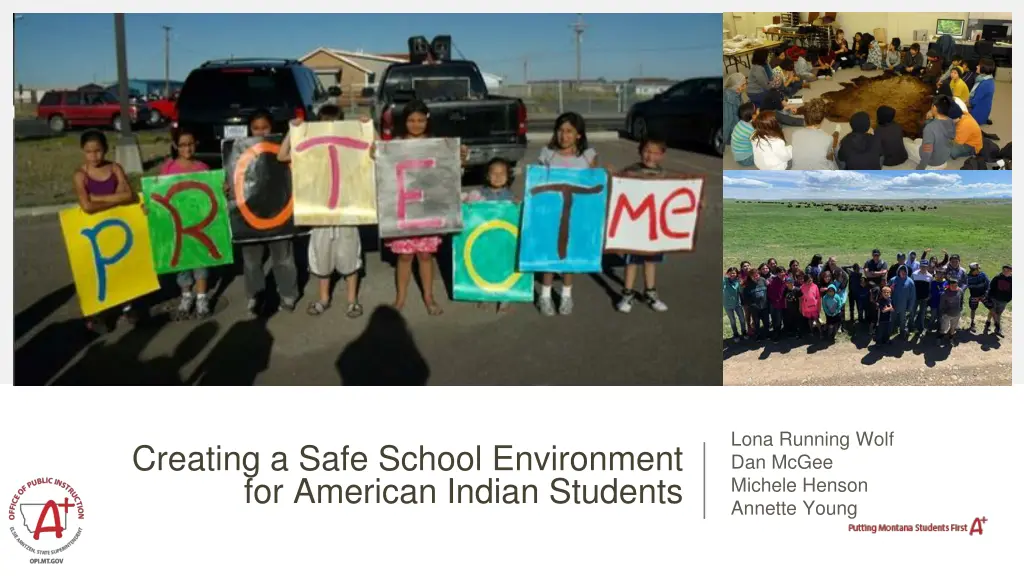
Creating a Safe School Environment for American Indian Students
Explore the unique safety needs of American Indian students and strategies for enhancing safety in schools. Gain insights on addressing implicit bias, promoting positive school climate, and fostering a sense of belonging. Discover practical takeaways and the Heart Butte Conceptual Framework for creating a safe and connected school environment.
Download Presentation

Please find below an Image/Link to download the presentation.
The content on the website is provided AS IS for your information and personal use only. It may not be sold, licensed, or shared on other websites without obtaining consent from the author. If you encounter any issues during the download, it is possible that the publisher has removed the file from their server.
You are allowed to download the files provided on this website for personal or commercial use, subject to the condition that they are used lawfully. All files are the property of their respective owners.
The content on the website is provided AS IS for your information and personal use only. It may not be sold, licensed, or shared on other websites without obtaining consent from the author.
E N D
Presentation Transcript
Lona Running Wolf Dan McGee Michele Henson Annette Young Creating a Safe School Environment for American Indian Students
Goals of Presentation Provide information on the safety needs of American Indian students Present workable strategies to increasing safety Reflect on how schools can conceptualize their desired safety strategies
Main Takeaways 40/60 split in perceptions about the achievement gap In schools, the importance of Indian educators cannot be downplayed Implicit/explicit bias from educators Revisiting the role of the school counselor Personalized learning: stakeholders see a need to make learning relevant, adaptable, and self-paced. (an increased focus on CTE, alternative education programs, or alternative graduation requirements.) Trauma is interwoven throughout the dataset both generational trauma originating inside the home and historical trauma. When students see their culture thriving, positive identity, well-being, and achievement are more readily formed and supported. Helping students develop an identity that is built of a sense of belonging to community and culture improves student well-being.
Heart Butte Conceptual Framework
Heart Butte School Safety Components Positive school climate Consistent routines School-wide behavioral plan Bully prevention plan Attendance matters Family Involvement
Positive School Climate School climate is the extent to which a school community creates and maintains: A safe school campus A supportive academic, disciplinary, and physical environment Respectful, trusting, and caring relationships All feel safe and connected
Positive School Climate Guidance for creating a safe and connected school climate: Asses the school s climate Emphasize the importance of two-way listening Take a stance against the code of silence Find ways to stop bullying Empower students by involving them in planning, creating and sustaining a safe school climate Ensure every student has a trusting relationship with at least one adult Be aware of the physical environment Emphasize an integrated systems model
Positive School Climate Considerations for American Indian students: Trusting relationships are vital: School staff with similar lived experience are key to establishing feelings of safety In addition to anti-bullying work, educate school staff on everyday discrimination Pay special considerations to space: Prominently and accurately display indigenous culture Create a space for AI students to make their own Student recommendation: Make school a place I want to be when life gets hard .
School-wide Behavioral Plans Trauma informed approach Restorative vs Punitive Tier 1 but includes MTSS approach Fair and Consistent Begins with consistent classroom management interventions Refocus rooms- using trauma informed practices Restoration plans
Assignments Should be Graded In a Timely Manner With Feedback Provided to the Students Monitor Student Grades Regularly and Inform Them of Changes Utilize Student Data to Guide Instruction
Rethinking Attendance Hope: Use school attendance as a tool to promote health and wellness Embed restorative practices in school attendance Restorative school attendance policies could: Support students after absences Identify modifiable barriers to attendance and wrap students and families in support Take a proactive approach to health and wellness (MMIW/MMIP)
Rethinking Attendance San Diego County Office of Education: cultural shift of using restorative practices within attendance intervention practices Team addresses attendance by: Identifying student and family concerns Opening channels of communication Supporting families to address barriers and linking students and families to resources
Rethinking Attendance San Diego County Office of Education school attendance policy recommendations: Prevention Efforts: Build a culture at school that promotes attendance Early identification of attendance problems with constructive intervention School Site Interventions: Interventions that students and families recognize as supportive vs punitive or judgmental Mediation Programs: Collaboration with law enforcement
Bully Prevention The Montana OPI believes in, and trains in Restorative Practice and the use of Circles, from a Montana Indigenous viewpoint. The historical and cultural significance provides you with a basic understanding, a respectful and meaningful connection to our First Nations inhabitants of our great state, and a place of beginning to fit the practice of Restorative Practice to your cultural norms, be it school and/or community. The book, Circle Forward: Building a Restorative School Community by Carolyn Boyes-Watson & Jay Pranis, provides everything from an overview of Restorative Practice to a myriad of templates to use Circles in your schools (from staff use to classroom instruction to community building to repairing a harm and more).
Templates Ready to Use Part I: The Basics Part II: Building a Positive School Climate Module 1: Establishing a Circle Practice Module 2: Establishing and Affirming Community Norms Module 3: Teaching and Learning in Circle Module 4: Building Connection and Community Module 5: Social and Emotional Learning Module 6: Important but Difficult Conversations Module 7: Working Together as Staff Module 8: Engaging Parents and the Wider Community Module 9: Youth-Ked and Peer-to-Peer Circles Module 10: Circles for Intensive Support Part III: Using Circles When Things Go Wrong Module 11: Learning Restorative Discipline Module 12: Restorative Discipline and Conflict Circles Module 13: Complex and Multi-Purpose Circles for Serious Incidents of Harm Module 14: Moving Toward Racial Equity Starting with Adults
Family Involvement IRIS Center https://iris.peabody.vanderbilt.edu/module/fam/challenge/#conten t
Overarching Themes Whole Child Approach Restorative practices Positive relationships Relationships between school staff and students Relationships between school staff and families/caregivers
Questions? Contact information: Lona Running Wolf Dan McGee Michele Henson: 406-595-1058 Annette Young
















